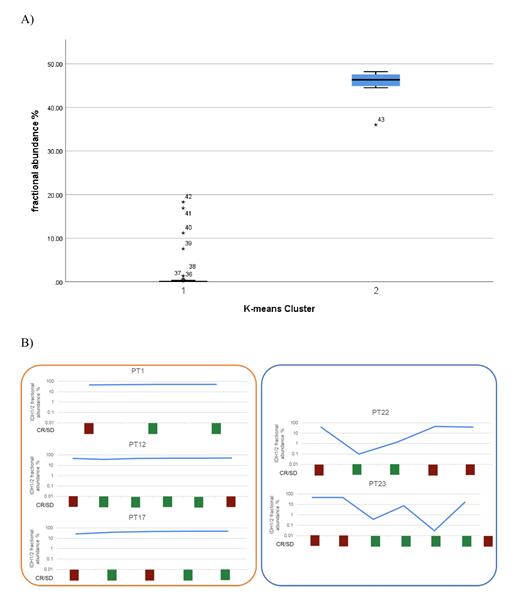Abstract
Rationale: Isocitrate dehydrogenase 1 and 2 (IDH1/2) mutations may be the nearest signal to in vivo leukemogenesis that we are able to see in overt acute myeloid leukemia (AML). Without immediate transforming activity and slow, metabolism-related effect, IDH1/2 mutations may be considered within the early events that made a myeloid stem cell a malignant one.
Methods: With the aim to investigate the behavior of IDH1/2 mutation in AML patients, we prospectively and longitudinally collected clinical data and samples of DNA extracted from bone marrow of consecutive patients. The study was approved by local Ethical Authority (012/2009/U/Tess, 01/2011/U/Tess, 10/2011/U/Tess and 253/2013/O/Tess). Droplet digital polymerase chain reaction (DdPCR) was performed with Bio-Rad's Qx200 DdPCR System© according manufacture instructions. DdPCR for all the samples were performed in duplicate. Serial dilutions were used to identify sensitivity limit of the method for each mutation included in the study.
Results: We analyzed 106 samples from 23 patients (median of 5 samples per patient). At database cut-off, 19th September 2020, median follow-up was 23.8 months (IQR 19.5 - 38.8). Fourteen patients were female. Median age at AML diagnosis was 59 years (IQR: 47.5 - 66). Most of the patients had normal karyotype (15/23, 65%) and 1 patient (4%) received diagnosis of AML after a previous myelodysplastic syndrome. Five out of 22 patients tested (23%) harbored FLT3 ITD, 8/21 (38%) had a NPM1 mutation. Almost the entire population (20/23, 87%) received intensive chemotherapy as induction regimen and 55% of these patients obtained complete remission (CR) after induction. Ten out of 23 patients (45%) harbored an IDH1 mutation, 2/23 (9%) R132G and 8/23 (35%) R132H; 13/23 patients (57%) harbored an IDH2 mutation, 7/23 R172K, 1/23 (4%) R172S and 5/23 (22%) R140Q.
Most of the samples were collected in complete remission (CR) (54.5%). Other samples were collected at the time of AML diagnosis (15.1%) or relapse/stable disease (37.3%). Median IDH1/2 fractional abundance was 45.3% (IQR 28.6 - 46.8) at diagnosis, 39.5% (IQR 29.5 - 48.0) at relapse/refractory, and .10 % (IQR: .05 - 17.24) in CR. Few cases showed a fractional abundance below 20% at relapse and only one case was IDH1 negative (during an extramedullary relapse).
The fractional abundance of IDH1/2 mutation in CR present a bi-modal trend, allowing us to define 2 groups by k-means stratification. Patients in group 1 (42 samples) tend to have a mutation specific fractional abundance that varies with disease burden (figure B, blue box). On the contrary, at the different time points patients in group 2 (group center 45.58%, 12 samples) have fractional abundance values over 30%, comparable to the levels at diagnosis, even in the absence of any other evidence of AML (figure B, orange box).
For NPM1, IDH1/2 positive patients, in 18 timepoints, NPM1 qPCR minimal residual disease (MRD) was compared with IDH1/2 fractional abundance selecting the best possible threshold (best possible threshold .083, predicted sensitivity 75%, predicted specificity 60%; R2= .763, 95% C.I.: .521 - .1.00; asymptotic significance = .062).
Finally, we selected 15 patients in which we were able to determine IDH1/2 mutation fractional abundance after induction therapy. Our results indicate that IDH1/2 ddPCR positivity does not impact on prognosis in our patient set.
Conclusion: Our study shows that IDH1/2 mutations are maintained throughout time in a subset of patients with IDH1/2 positive AML in CR and that they do not univocally correlate with levels of residual disease. In these AML patients, the persistence of IDH1/2 mutations may be part of a more complex process involving clonal hematopoiesis. In such setting, further studies on the biological and clinical significance of IDH1/2 mutations persistence are warranted.
Martinelli: Abbvie: Consultancy; Astellas: Consultancy, Speakers Bureau; Jazz Pharmaceuticals: Consultancy; Daichii Sankyo: Consultancy; Pfizer: Consultancy, Speakers Bureau; Roche: Consultancy; Celgene /BMS: Consultancy, Speakers Bureau; Incyte: Consultancy; Stemline Therapeutics: Consultancy. Papayannidis: Pfizer, Amgen, Novartis: Honoraria. Cavo: Takeda: Consultancy, Honoraria, Membership on an entity's Board of Directors or advisory committees, Speakers Bureau; Adaptive Biotechnologies: Consultancy, Honoraria; Novartis: Honoraria; GlaxoSmithKline: Consultancy, Honoraria; Amgen: Consultancy, Honoraria, Membership on an entity's Board of Directors or advisory committees, Speakers Bureau; Sanofi: Consultancy, Honoraria, Membership on an entity's Board of Directors or advisory committees, Speakers Bureau; AbbVie: Consultancy, Honoraria, Membership on an entity's Board of Directors or advisory committees; Janssen: Consultancy, Honoraria, Membership on an entity's Board of Directors or advisory committees, Other: TRAVEL, ACCOMMODATIONS, EXPENSES, Speakers Bureau; Celgene: Consultancy, Honoraria, Membership on an entity's Board of Directors or advisory committees, Other: Travel Accommodations, Speakers Bureau; Bristol-Myers Squib: Consultancy, Honoraria, Membership on an entity's Board of Directors or advisory committees, Speakers Bureau. Curti: Novartis: Membership on an entity's Board of Directors or advisory committees; Pfizer: Membership on an entity's Board of Directors or advisory committees; Jazz Pharma: Membership on an entity's Board of Directors or advisory committees; Abbvie: Membership on an entity's Board of Directors or advisory committees.


This feature is available to Subscribers Only
Sign In or Create an Account Close Modal